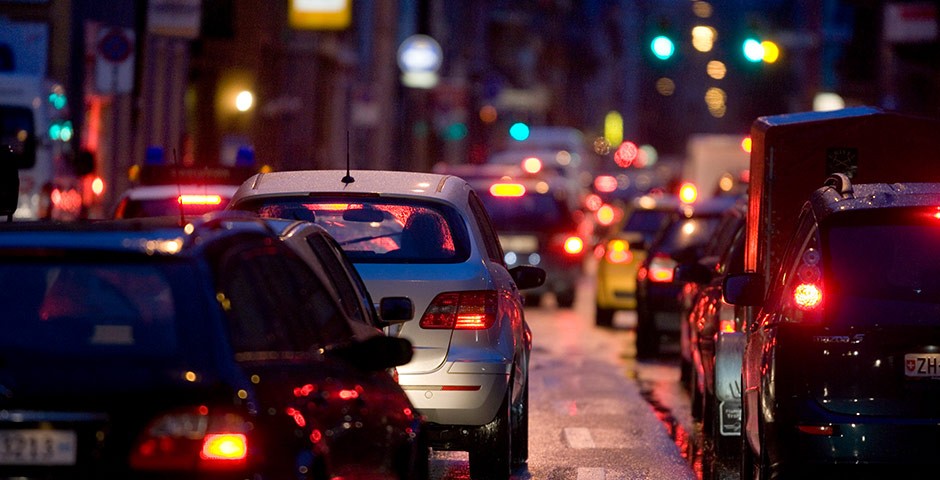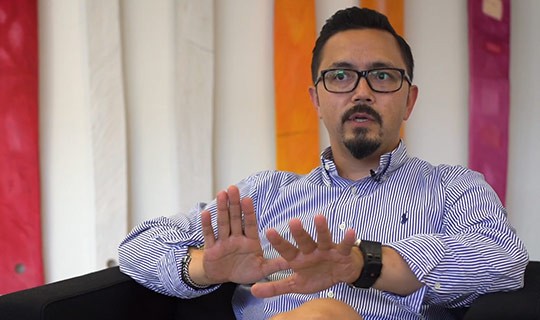
Smart mobility
5G: more speed for less congestion
On motorways especially, traffic jams could be substantially reduced with technical help. For the reasons why traffic is frequently anything but fast on motorways are surprisingly simple.
Roger Baur, 20 July 2018
It’s the same story every day from 6 am and 4 pm. And today is no different. On a host of monitors, Jessica Ladanie from Viasuisse is watching what is happening right now on the motorways. The number of vehicles is increasing, the traffic is becoming more aggressive and more and more people are switching lanes. This results in deceleration, evasive manoeuvres – and then sluggish lines of bumper-to-bumper traffic, followed by jams. “In 80% of cases, traffic jams are simply the result of people not driving carefully. Things like abrupt braking, unnecessary lane changing and unfocussed driving”, explains Ladanie, who leads the German-speaking editorial team at Viasuisse.
Will traffic jams soon be a thing of the past? Will traffic bulletins on the radio soon be redundant? Will the future 5G mobile generation make a difference? Video by: Tobias Frehner, Angela Staudenmann. Total video length 02:45 min.
It’s a fact that, even when the traffic is heavy, traffic jams are not inevitable; they are simply a consequence of irrational behaviour. As an example, Jessica Ladanie points to the motorway section from Bern in the direction of Härkingen. Reducing from three to two lanes immediately after an exit should not pose a problem in terms of capacity – but it causes regular traffic jams with delays of up to 45 minutes. And there is one simple reason: people trying to jump the queue abuse the zip-merging system and cause deceleration. That has a knock-on effect and results in a traffic jam.

“5G offers huge potential for making traffic more intelligent and free-flowing in the future.” Damian Birch, Head of Solutions and Technology at Viasuisse.
Most navigation systems (currently) lack the information
Sometimes there’s nothing that Jessica Ladanie and her team can do but to offer a futile warning. “Don’t try to bypass the traffic jam”, she says in a radio interview – but a short time later the monitor shows that this warning has again been in vain. Lots of cars are leaving the motorway in the hope of finding a quicker way. This type of human behaviour is deeply ingrained – and it’s also a big mistake. There’s a simple rule of thumb: if you can see the traffic jam ahead, it’s likely that so many drivers have already left the motorway that any diversion will take you longer. Drivers can sometimes waste hours on country roads when they would have got through the traffic jam on the motorway in minutes. People often switch on the advice of their navigation system too. But they respond too slowly to diversions. According to Ladanie they “only work in black or white terms of traffic jams or free-flowing traffic. We might have information that the scene of an accident will be clear very soon but a system like that doesn't have this information.” Not yet, at least. Traffic information is now facing its greatest revolution – one that, in the best-case scenario, may even make it superfluous.

“5G is the basic prerequisite for the autonomous driving of the future.” Thomas Rohrbach, Federal Roads Office (FEDRO)
The winning formula for preventing traffic jams on motorways especially in the future has two ingredients: speed and integration. To put it another way: traffic bulletins will be prepared more quickly and sent directly to vehicles. Integrated systems such as distance sensors or cruise control will automatically adapt their behaviour. Damian Birch, Head of IT at Viasuisse, explains that the impact can already be seen. “With many new vehicles equipped with distance control functions now, we are already seeing less congestion.” In the future, systems like this will react faster and be more precise. Companies like Tesla and BMW are relying on 5G – the mobile network for the next generation is the prerequisite for feeding information to vehicles. “In and of itself, the fact that each vehicle constantly changes its position creates huge quantities of data that need to be processed. Today's mobile network can’t deal with that or process it quickly enough”, explains Birch.
Will traffic bulletins on the radio soon be redundant?
Soon it won't just be Viasuisse that communicates with the driver via the radio. In the future, vehicles travelling further ahead will be able to transmit signals to those following close behind – within milliseconds. At its most effective, this will prevent accidents as well as congestion. “Ideally”, says Jessica Ladanie with a smile, “our job will become unnecessary.”
Viasuisse
Viasuisse is the national traffic information centre in Switzerland, based in Biel. It was formed in 2001 and is owned by SRG, TCS, SBB and Skymedia. A staff of 26 provide details of incidents and restrictions on the entire public road and transport network in Switzerland.
More on Viasuisse
Why 5G is needed for the transport network
We’re not talking about the car of the future here – nowadays, many new cars are already networked. This means that the technology required to avoid traffic jams is becoming more widespread, and older models from 2004 onwards can even be retrofitted with solutions such as "Autosense".
However, the network is proving to be the weak link: whenever road traffic is networked, huge volumes of data are generated. Each day, more than 7 million vehicles use the Swiss motorway network alone, and their position changes by an average of 27 metres per second. These two figures highlight not only the huge data volumes generated but also the need to process this data incredibly quickly. The current 4G network lacks both the capacity and the latency required to do this. There is agreement among experts such as Thomas Rohrbach of the Federal Roads Office (FEDRO) that 5G is essential for the transport network: “If vehicles on the road are automated or partially automated, then we need ultra-fast communication links to ensure they have split-second information about where the next vehicle is and what is happening ahead, behind and next to them. This is where companies like Swisscom have a huge role to play.”
Swisscom will begin its 5G rollout in 2018. This will not only serve the transport solutions of the future but will also greatly benefit other areas where new networks are needed urgently, such as industry, healthcare and energy production.
More about 5G

We are installing 5G
Swisscom is on schedule to roll out the latest mobile generation, 5G, in Switzerland this year.